
Jupiter Hell PC Review
I remember when I was covering a battle royale game last year called Spellbreak, a rather good one I might add, and in that opening paragraph, I mentioned how the Buzz Lightyear meme of “X, X Everywhere” was so appropriate to that genre. Having handled a lot of Trailer Attacks on the site, I feel I should correct myself and apologise to the battle royale genre because clearly that is no longer the leader in been overused. That win surely belongs to the roguelike. It easily takes the gold medal – searching for the tag on Steam brings back over 3,000 titles, so fans of those games have plenty of options to pick from. Jupiter Hell is going to have to do a lot of ripping and tearing to get through the noise of the competition to show the audience why it should be played this year – hint: it should.
Doom fans might have noticed that little nod to id Software‘s first-person shooter in the opening paragraph. This is because there is some history behind the birth of Jupiter Hell. The developer, ChaosForge, initially created a fan-made game called Doom, the Roguelike, shorten to DRL after a cease and desist notice was sent to the developer by ZeniMax Media to stop using the Doom name. DRL took the themes of Doom and Doom II and morphed, as the title suggests, into a roguelike. Jupiter Hell is looked upon as a spiritual successor to DRL, starting life on Kickstarter back in November 2016, then jumping to Steam Early Access in 2018, and now releasing version 1.0 in August 2021.

As with Doom, Jupiter Hell skips any notion when it comes to story. The game keeps it simple and straight to the point to set up the themes of the game through a flashy animated cutscene. The player is an alone marine who has to make an emergency landing on one of the moons of Jupiter, where he finds out everyone is dead, so must make his way through the legions of zombie humans, beasts and demonic forces to escape what is essential hell on Jupiter…get it? Yeah, okay, so it is not the most imaginative name, but it is straight to the point, just like the game itself.
This is going for the 90s sci-fi feel and look. The visuals are old school, given a stylised CRT monitor look by bending the image every so slightly on the screen. The hero likes to swear, is ready to kill without hesitation and has many one-liners ripped straight from other games/movies of that era, and of course, the music is heavy metal, which fits well with the theme of the game. If Doom 2016/Doom Eternal taught me anything, it is that I love to wreck demons to some quality metal tunes, although Jupiter Hell is a bit more generic in its metal music, it does make the action more satisfying.
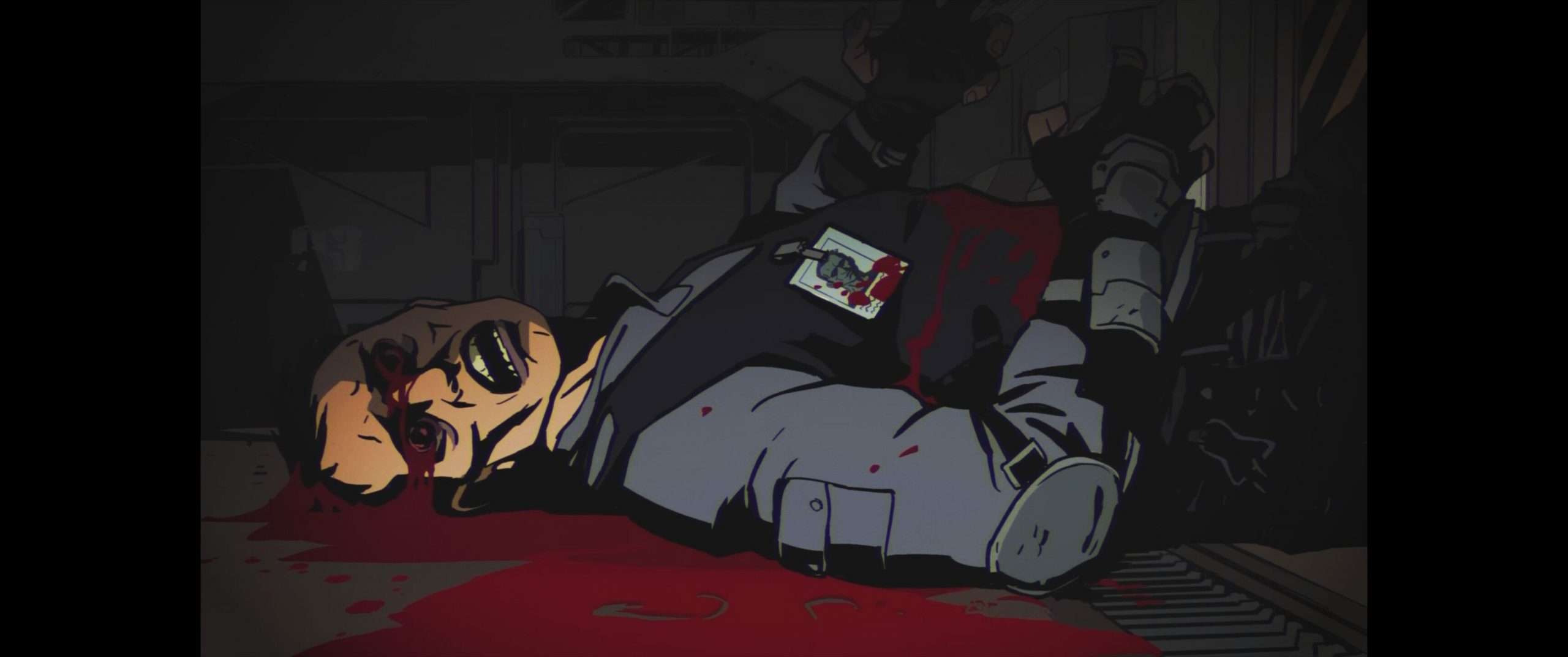
Everything is quick in Jupiter Hell, even the tutorial joins in this by letting you know that it will only be a couple of minutes long before you are set free to journey into hell. This is due to Jupiter Hell being easy to understand. It does away with any of the overly complicated mechanics that can sometimes be part of roguelike games. This is not necessarily a dig at past roguelikes, but when something comes along that claims to be inspired by the hyper-action of Doom, then yeah, the player is already expecting something from the developer, and thankfully the team knows this and has incorporated frantic action into the classic roguelike formula.
It all starts with “Regular” game mode. I say this because regular is the core of the game experience that other modes then modify to switch up the challenge. A few modes are initially locked and require certain accomplishments to be met before they open up, which is done through this regular mode. The same is for the difficulty selection, as Easy, Normal, and Hard are available, but Ultraviolence and Nightmare! require unlocking by once again hitting certain achievements. In fact, there are so many achievements, medals and badges to earn that I feel this is a dream for players who love to try beat everything in a game. I am not good enough to beat this game on its highest challenge, so some of these badges will be never unlocked.
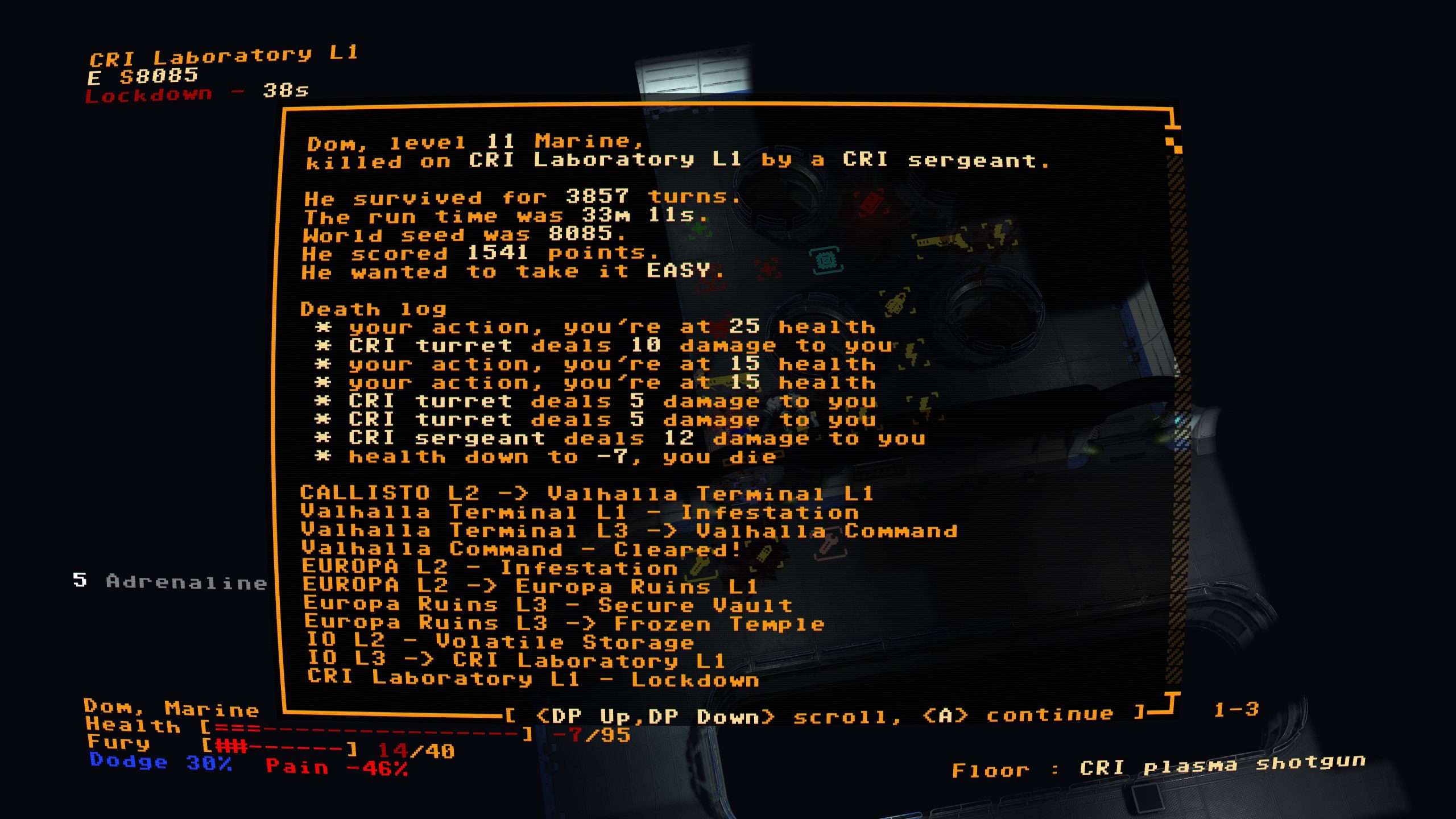
Starting a run begins by picking between three classes (Marine, Scout, Technician) each one coming with their own skills and traits (resource, passive, active). Marine is what you would expect DoomGuy to be. This class has a resource based on Fury, which fills up a metre from each kill. This leads into Marine’s active skill that casts adrenaline, allowing Marine to heal and convert the pain modifier to health and gain protection for 5 moves. Lastly, these gun-tooting fighters regain 10% of their health when entering a new level. Scouts can spend energy to active stealth for a few turns, making them undetectable and perform a critical hit when attacking during stealth. To gain resources to use stealth, the Scout has to open chests to build this metre, while their passive shows locations of standard elevators, which is how the player transfers to the next level. Technicians are for people who like messing with equipment. Their resource use power by picking up power orbs that drop from mechanical enemies. The knowledge of equipment means they can use items, such as grenades or health items, twice as fast as any other class, and the active skill is based on dropping smokescreens around the character to block enemy sight. All these classes go for a different play style, and each one also has unique upgradeable traits that focus on their skill set. Three classes is limited compared to other similar games, but it feels as if the developer put in the time to make sure each one is different to play within the game’s mechanics.
Classic roguelike mechanics are the building blocks of Jupiter Hell. This translates into meaning that the game is turn-based where movement is tied to grids on the ground. Every action counts as a turn for both the AI and the player, which is done simultaneously. This manages to keep the game fast, almost in real-time, where in some instances it can come across as an isometric shooter. One thing to note is that the game does not support mouse as an input, this is strictly a keyboard or controller game, with movement tied to the keys or the d-pad depending on the input device used. The developer states this is because of the animation blending system used that enables the game to run as fast as the player entering the inputs, which is why it comes across as rapid as it does. Controls are easy to understand, mainly because there are not many buttons used. Another thing that helps keep things moving is the fact that the direction of the player model has no bearing on the game, it is a visual effect, as the game will highlight the enemy that is the focus of an attack. If multiple enemies are within range then a button can switch it to another target. I am sure people who have incredible responses will have this under control and it will not impact their ability to get through the levels in haste.
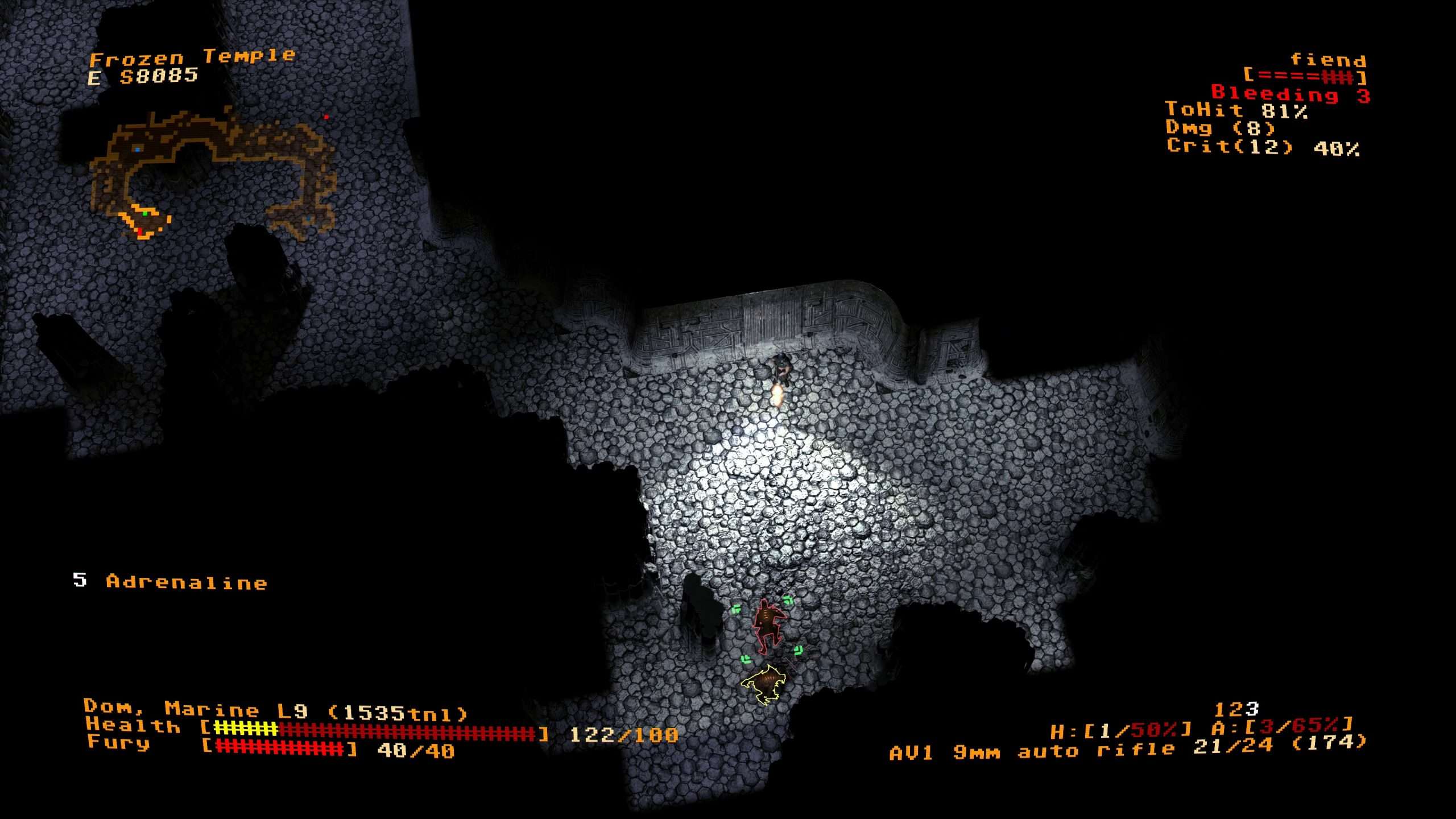
The fast pace can give a false misinterpretation, it is still turn-based gameplay with numbers controlling the elements of the title, so a strategy needs to be accounted for in the later floors. There is no rewind, no respawn, no way to come back from death – it is back to the start with the starting gear again. Nothing is kept permanently, making every run fully fresh and random. It is reasonable to slow down the pace in unexplored areas because of the risk of death. The fog of war covers both the on-screen map and the visuals, in which enemies are not visible until they are detected or have been revealed through a trait/item that has been gathered during a run. Both the player and enemies can use cover to reduce the hit chance percentage, or items, like smoke grenades, to make it harder to hit. But the player also has to remember that firing, reloading, and using items all use a turn, giving enemies a chance to get closer or deal damage.
You have to fight against the urge to go on a thoughtless rampage because the weapons are fun to use. There is quite the selection, and of course, there are the Doom-inspired guns as well. Weapons fall into types – melee (katana, machete) pistol (9mm, desert eagle), sub-machinegun (9mm, .44), semi-automatic(sniper, railgun), automatic (assault rifle, nail gun), shotgun(frag, jackhammer), launcher(rocket, BFT 10k), and rotary (chaingun, super nailgun). My favourite is the shotgun, mainly for the fact that it has such a large area of effect, which can deal great damage to enemies grouped together. On the Armour side, there is not much apart from the head and body bits that can be found to offer some additional support. No matter if it is weapon or armour, both have rarity colouring that anyone who plays action RPGs will be familiar with (common, uncommon, rare, legendary, etc.)
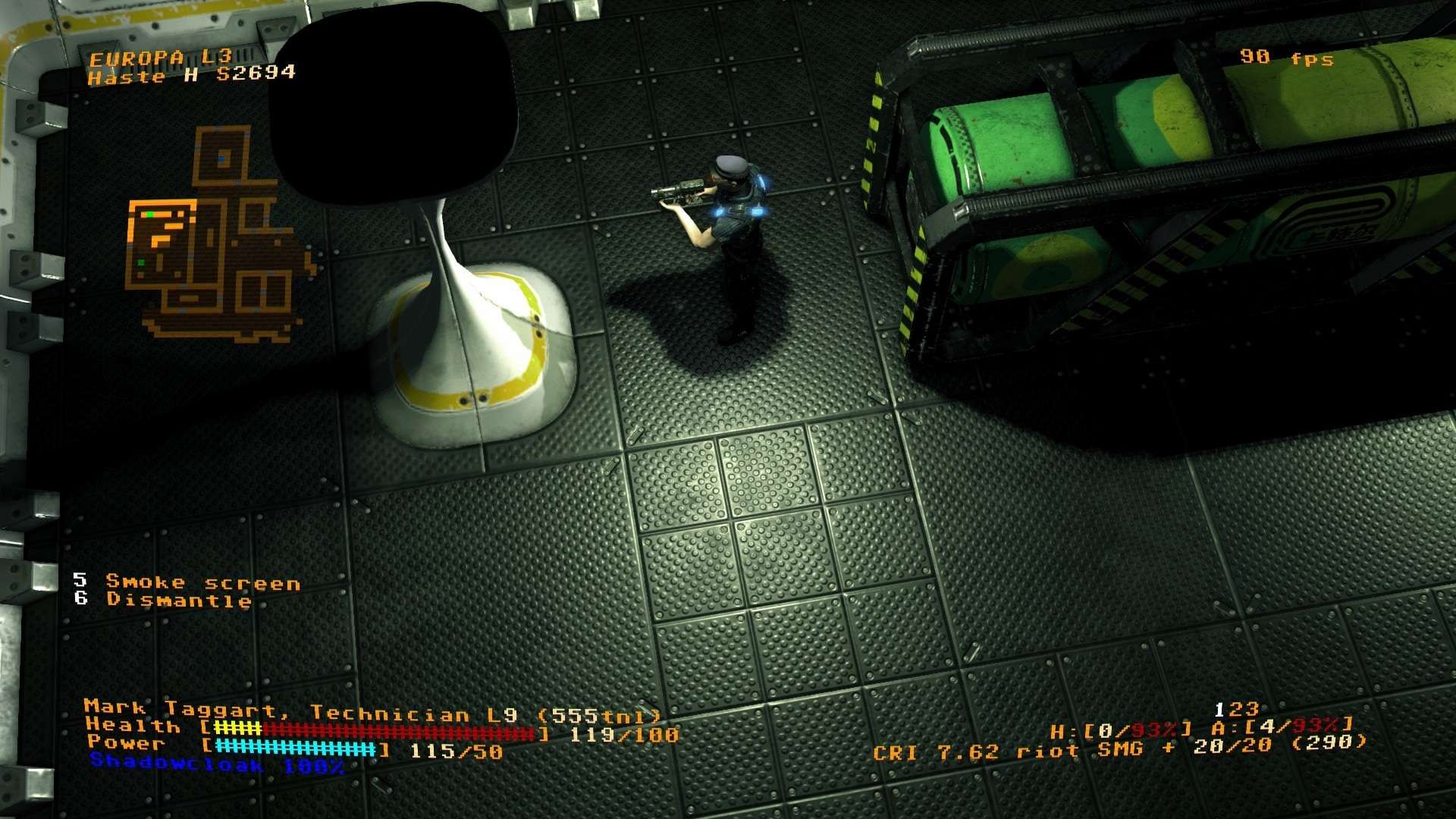
There is a balance between saving/using health kits, as limited supplies in a run means careful use to replenish missing health, and since inventory has limited space then decisions need to be made what to keep/drop as the player makes their way through each floor. Enemies use the same weapons and will drop items upon death, such as ammo, items, or weapons, which can be picked up, or in the case of explosives, can actually be used from the floor, saving a turn in dropping/picking weapons. Enemy types can cover the spectrum of soldiers, demons, robots – just imagine it’s a top-down Doom and you’ll get the drift.
Level design is fairly straightforward since they are built with tileset in mind, with the objects filling in bits of the map to offer the randomisation of where a player can travel and what buildings and items fill the level. This helps with rewarding exploring, as not only does filling out the map for each floor mean new items, but also added experience as there are more enemies to fight. This is a risk though, since a player could easily end up wiping themselves in an unlucky entry to a room full of bloodthirsty foes. There are four zones, each one made up of a few floors that can branch off into smaller areas to extend the run for longer. The themes cover military complexes, rocky caverns, space stations, lava caves. The visuals are fine for the game, but in reality, all they are doing is giving the same grid mapping a new coat of paint through the themes.

What is neat is that each environment can have a randomised event to throw in something a little different. The power could be out, which shortens the vision range, there could be a higher count of explosive barrels scatted in groups, security could be on alert, in which drones start searching for the player, or one of the more painful ones called “The Hunt“, which has all enemies knowing the player’s location as soon as a timer reaches zero. A painful experience, but a bloody fun one if it goes in your favour. There is also added interactive objects called terminals that have journals that can inform where secrets are located. This could be on the same floor or a few floors ahead. These terminals also allow the use of multi tools, items that are picked up as loot, to enable an option, such as disabling turrets, hacking turrets to attack enemies or unlock doors.
As with many roguelikes on the market, Jupiter Hell hits that sweet spot where you just want to do another run. It has an addictive and rewarding gameplay loop, which is thrilling due to its easy to understand rules. A run can go successfully or badly, but I feel there is also more the player can do in Jupiter Hell to try correct when a run turns bad through the skills, traits, plenty of rare weapons, items and terminal drops. Although I still cannot say I am good at learning that, succumbing to the habit of falling into the game’s fluid movement ends up making me forget that I need to stop and approach the unknowns carefully otherwise many more instances of been overwhelmed will happen. It falls short when it comes to its complexity of customisation, there aren’t many different builds, but it makes this up with its weapon selection and the uncertainty of randomisation.
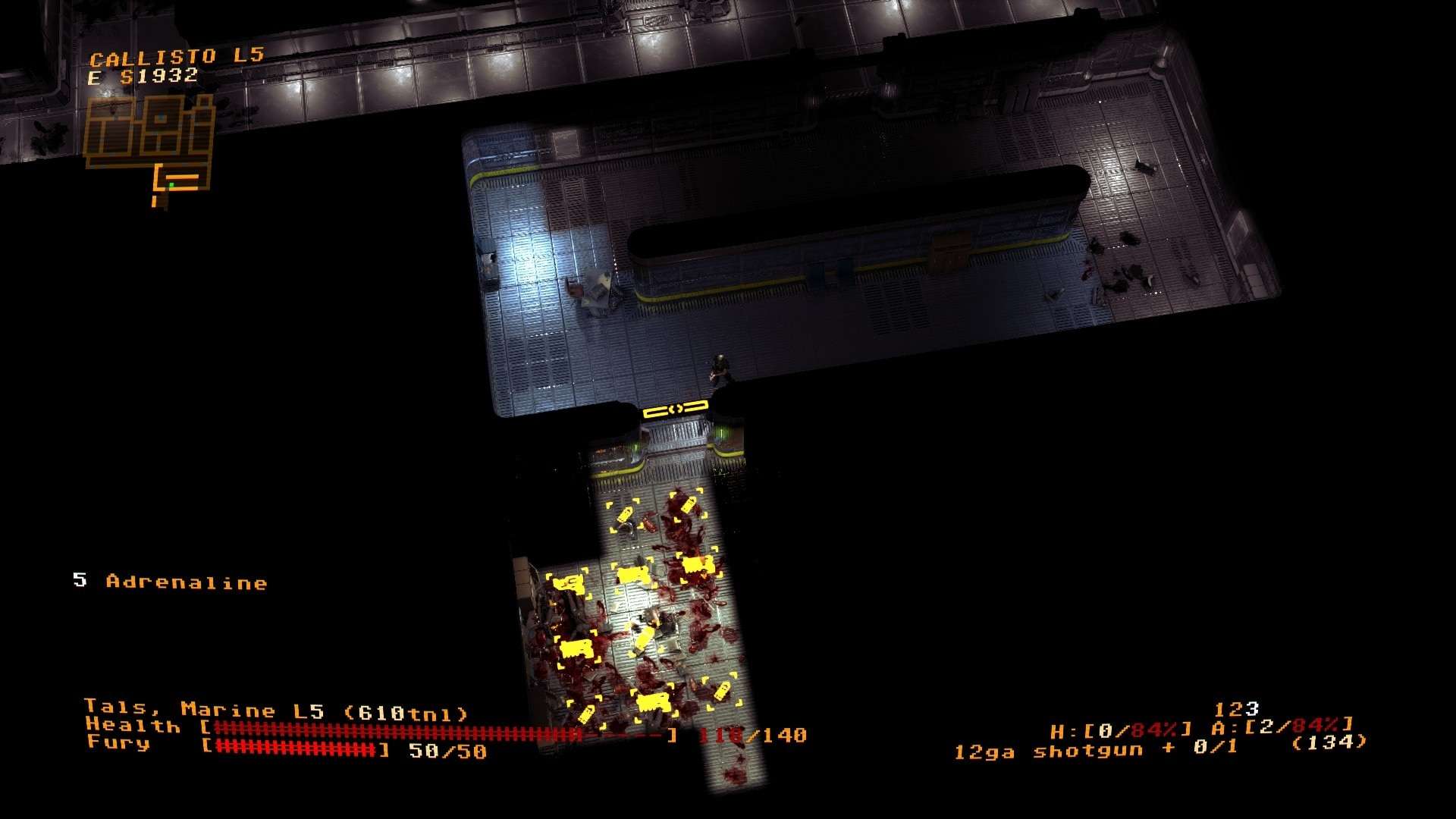
Jupiter Hell is a lot of bloody fun, hard fun, but one that did not put me off trying to improve myself after each permadeath. It helps that Jupiter Hell is simple to pick up. It may not have the depth of the modern roguelikes that come with many build options and classes, but it has just enough to make each of the three classes distinct in their style that people will pick a fave (Marine, obviously!) I have nowhere near beaten everything the game has to offer, so I can see this one lasting many, many hours.
I will hold my hand up and say I have not played many roguelike titles, as it is a genre I am not all that great at. But the way this game is built kept me playing, pushing forward to beat my highest score. Jupiter Hell does this by focusing on making the action sublime and fast, and anything that would interrupt the flow of gameplay is kept to a minimum. It gives this turn-based game a very unique feel, fitting closely to the inspiration its themes come from. Jupiter Hell is made for people who might not normally enjoy roguelikes or for people who have played the modern take on the genre and want a game that goes back to the old school rulebook, but brings with it some looter shooter, straight to the point, action.
